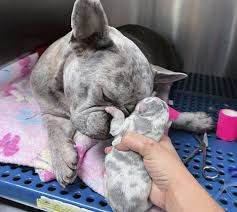C-Section for Dogs
Ensuring the health and safety of your pregnant dog and her puppies is a priority for every responsible pet owner. Sometimes, complications during labor necessitate a C-section for dogs. Here’s what you need to know about this procedure.
Keyword Phrase: C-section for dogs
What Is a C-Section in Dogs?
A C-section, or Cesarean section, for dogs involves the surgical delivery of puppies through an incision in the mother’s abdominal wall and uterus. This procedure is typically recommended when a dog cannot deliver puppies naturally and can carry risks for both the mother and her puppies.
Common risks include reactions to anesthesia, infections, bleeding, blood clots, and injuries to the uterus or puppies.
Signs That Your Dog Needs a C-Section
Determining when a C-section for dogs is necessary depends on several factors. Your veterinarian will assess these signs to decide if the procedure is required:
Weak contractions for over two hours without producing a puppy.
Heavy contractions for 30 to 60 minutes without producing a puppy.
Signs of illness such as fever, pain, and vomiting.
Discolored vaginal discharge (e.g., pus-like, bloody, green, or greenish/black).
Mispositioned puppies in the womb.
Dogs that have been straining for more than four hours without delivering puppies or have more than two hours between puppies may need veterinary intervention.
Preparing Your Dog for a C-Section
If a C-section for dogs is planned, it's essential to prepare your dog accordingly. Here are some steps to take:
Avoid applying fresh flea and tick products for at least a week before the C-section.
Bathe your dog shortly before the surgery to ensure she is clean.
Discuss with your vet any medications that may need to be administered on the day of surgery.
A pheromone-based collar might help ease your dog’s stress before surgery.
Fast your dog a few hours before the surgery, though water is usually allowed until you leave for the vet.
Routine preventative care, regular exercise, and maintaining a healthy weight are crucial for ensuring a successful surgery for both mother and pups.
What to Bring to the Veterinary Hospital
When heading to the vet for a C-section for dogs, having a few items on hand can make the trip smoother:
Seat covers for your vehicle to manage post-op discharges.
A large dog crate with a thick lining of blankets for safe travel.
A heating pad to keep the puppies warm during transit.
A separate kennel for the puppies to ensure they aren’t accidentally hurt by mom.
Formula and bottles in case the mother isn’t ready to nurse immediately.
Your cellphone and charger for communication and emergencies.
What Happens During a C-Section for Dogs
At the veterinary hospital, several steps will be taken to prepare your dog for a C-section:
Physical and vaginal exams to check puppy placement and signs of labor.
Imaging (X-rays and ultrasound) to assess puppy placement and heartbeats.
IV catheter placement and fluid administration.
Blood work before surgery.
Sedation and induction of anesthesia.
Shaving and cleaning the abdominal area.
Wrapping the tail to keep it clean during surgery.
The puppies are usually delivered quickly, and the remainder of the C-section is completed while the veterinary staff wakes the puppies from anesthesia.
Post-Operative Care for Your Dog
Post-operative care is crucial for recovery after a C-section for dogs. Your vet will provide detailed instructions on when to allow puppies to nurse and any necessary medications to prevent infection or manage pain.
To help the new family thrive:
Observe from a distance without disturbing them too much.
Use a camera to monitor the nursery area without being intrusive.
Keep canine milk replacer and bottles on hand for supplemental feeding.
Use a heat support device if any puppies become chilly.
Weigh the puppies daily with a gram scale to ensure they are gaining weight consistently.
When to Call Your Veterinarian
If you notice any concerning signs, contact your vet immediately. These signs include:
Redness or discharge from the incision site.
Fever or decreased appetite in the mother or puppies.
Weakness, lethargy, or seizures in the mother or puppies.
Puppies that are not nursing or gaining weight.
Cold puppies or those separated from the litter.
Always consult your veterinarian if you have any doubts or concerns about the health and well-being of the mother and her puppies after a C-section for dogs.
For more information and resources on canine health and pregnancy care, visit k9reproduction.com.


Comentarios